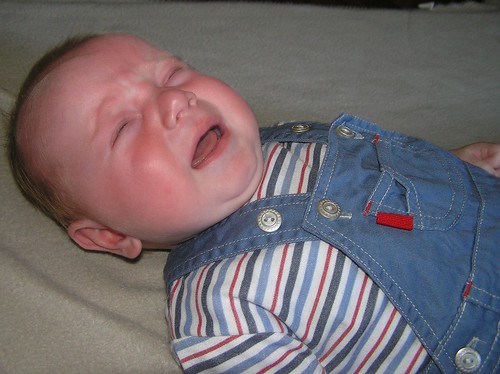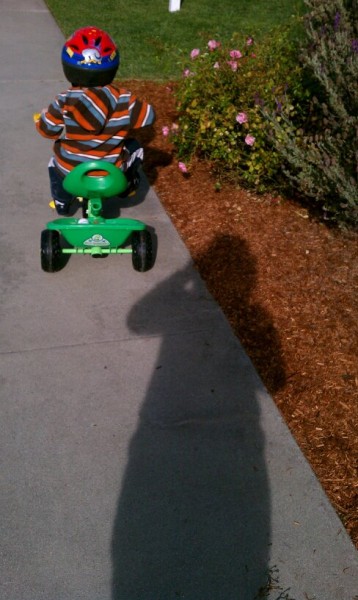“Crying must be responded to. But how is a more complicated issue. To follow the advice, “do not let your baby cry,” is practically impossible. At times the harder a mother or father tries to stop the baby’s crying, the more anxious everyone becomes.” Magda Gerber
In The Dangers Of “Crying It Out“, published this week in Psychology Today, psychologist Darcia Narvaez argues not only should babies never be left to cry for any reason, but in fact, parents have an obligation to parent in a way that will prevent any crying at all, lest the baby suffer a whole host of emotional and physical repercussions, including brain damage.
She argues that it’s not normal for babies to cry: “A crying baby in our ancestral environment would have signaled predators to tasty morsels. So our evolved parenting practices alleviated baby distress and precluded crying except in emergencies. Babies are built to expect the equivalent of an “external womb” after birth. What is the external womb? —being held constantly, breastfed on demand, needs met quickly. These practices are known to facilitate good brain and body development. When babies display discomfort, it signals that a need is not getting met, a need of their rapidly growing systems.”
Reading the article, I found myself asking “Really, Doctor Narvaez?”
Apparently Narvaez is not familiar with the period of Purple Crying, which is an evidence-based infant abuse prevention program which aims to educate parents about normal infant crying and its relation as a trigger for abuse. Purple refers not to the color the baby turns when he or she cries, but to:
P–Peak of crying. The worst crying tends of occur around 2 months of age and decline from 3-5 months.
U–Unexpected. The crying often comes on and stops for no apparent reason.
R–Resists soothing. The baby is often difficult to soothe.
P–Pain-like face. The baby may appear to be in pain even if they are not.
L–Long-lasting. The crying may go on for several hours a day.
E–Evening. The baby often cries more in the late afternoon or evening.
The goal of the Click For Babies project which is being organized by the National Center on Shaken Baby Syndrome (NCSBS) is to help parents understand that frequent and sometimes intense crying is often normal in the first few months of life, and does not necessarily mean anything is wrong with the baby, nor does it mean the parent is inadequate or doing anything wrong if they aren’t able to stop their baby from crying. The hope is that by educating parents about this common developmental stage, many may be helped to learn to respond sensitively, while preventing cases of Shaken Baby Syndrome, which occur more commonly when babies are especially fussy.
Doctor Heather Wittenberg, “The Baby Shrink” (and mother of four), was similarly outraged by the polarizing tone and misinformation in Narvaez’s article, and she wrote a short, but pointed response, in which she concluded:
“The fact is, there is no evidence whatsoever that occasional CIO in typically developing babies causes any damage. PERIOD. More importantly, there IS evidence that severely sleep-deprived mothers are at much higher risk of developing an already common –and dangerous — condition: postpartum depression. And PPD certainly CAN lead to long-term damage to both baby — and the entire family. CIO is a method that, when implemented thoughtfully, can often lead to improved sleep (and health and happiness) for everyone.”
Janet Lansbury posted Dr. Heather’s response to the Psychology Today article on her Facebook page, prefacing it with a note that asked: “What do you think?” Within a few hours 58 responses had been logged, which speaks to the very strong feelings aroused when people hear the words baby and crying (or “crying it out”) in the same sentence. Dr. Heather received an equally overwhelming and intense response on her site, and some of the responses were barely civil. It seems this is a conversation that needs to continue to happen. There is so much emotion, judgment, misinformation, and misunderstanding around this issue, and that’s not good for parents or babies. Also, the question of how to respond to a baby’s cries goes right to the core of how we view babies, and how sensitively and respectfully we care for them.
Janet Lansbury has written eloquently on the topic on numerous occasions, most recently in 7 Reasons To Calm Down About Babies Crying where she says: “When babies cry, our job is to tune in, provide help, love and support as needed, but not necessarily stop the crying.”
The number one question and concern new parents have is this one: “Why does my baby cry? What’s the best way to respond when s/he cries?” I also have parents come to me who are beyond exhausted, and desperate for some sleep (when their babies are a year old or 15 months old, and still waking many times a night), but fear they will somehow be harming their baby if they allow so much as a whimper. What’s a parent to do?
One of the responses to this discussion was penned by Carla Prosch, who is an early childhood professional currently working as a nanny for two families in Seattle Washington, and is herself the mother of two children. Her response was so thoughtful, and so closely mirrors my own progression of thinking, feeling, and understanding about babies and crying, that I asked her if (and she graciously agreed) I might share her words here:
“I really appreciate the dialogue going on here because I find it all very fascinating. It seems that it would be so much easier if there was ONE WAY to handle all situations with all children at each developmental stage. Imagine if there was only one book to be used and we all took that book home in our diaper bags when we left the hospital. That would be too easy (and probably kind of boring).
A few months ago I wrote some thoughts about babies and crying and had decided that I had many more thoughts to include. I recently realized that when I have worked with babies and toddlers in a group care situation, I have to fight against a deep ingrained (belief? feeling? cultural norm?) that I have learned. This subtle belief that I have is that when babies/toddlers are crying, it’s my job to get them to stop (I don’t really believe that, but I think I FEEL that deep down, subconsciously). Or, perhaps to even prevent the crying from happening in the first place! If they continue to cry, I must not be doing my job well (subconscious feeling, I don’t truly believe this). Now here’s the switch (a truth for me) – when babies cry, it’s my job to figure out why and to support them in whatever way is necessary while they cry for as long as they need. I believe in observing them and then sensitively responding to them.
Think of it this way; imagine the director of a program is walking through your classroom with a tour of prospective parents. If the children in the room are actively engaged and relatively calm, as a teacher it feels very different than if the children are actively engaged in other ways that are not so calm, grabbing a toy from somebody, crying because a limit was set (typical, developmentally appropriate infant/toddler behaviors). There seems to be so much more “stuff” that has to be explained in the second scenario. You usually don’t hear something like this from the first scenario, “Parents, I know what you are observing now is something that might feel a little uncomfortable to you, the children are actively engaged and calm. That’s because the teachers in this room have set up a stimulating environment and are keenly observing the children to support them as they play.” Both scenarios happen and to me, both scenarios are healthy but scenario #1 is always easier to feel confident about. I think a lot of that has been learned within our culture.
So that is my recent personal journey about crying in general. What about CIO? I think, as we all know, there are many different ways to approach situations with children. What matters most is that each of us can make informed, thoughtful, intentional decisions based upon multiple factors within each family (the child’s temperament, family culture, the level of support families are receiving, etc). I believe in four key goals: 1) Striving to build a caring community of loving support with one another, 2) Sharing our thoughts and feelings with each other genuinely and authentically, 3) Being heard without judgment, and 4) Respectfully agreeing to disagree when necessary.
What is very important to me is empowering families to make each choice for their own child, realizing that they are the only true expert on their child. Nobody will ever know a baby as well as the mother and/or father know him/her. And in the end, when our children are grown and we look back on the personal choices we made, we will (hopefully) know that each choice was made in the spirit of good intention and genuine thoughtfulness.
Looking back at choices my husband and I made together, we realize now many things that we would have done differently because of experiences we have had as we have gotten older. However, we are confident that we did the best we knew how to do at that given moment in time with the very best intentions (adding into this equation – imperfect humanness). We did not do CIO with our two children (now 13 years and 8 years old), but if we were to do it over, we would definitely choose to use the CIO approach, as appropriate, while observing our children in the process.
I say all of this not from a place of knowing but from a place of “this is where I am right now”. The topic of crying really stirs up a lot of discussion in people.”
And now, it is your turn. What are your thoughts on babies and crying?

